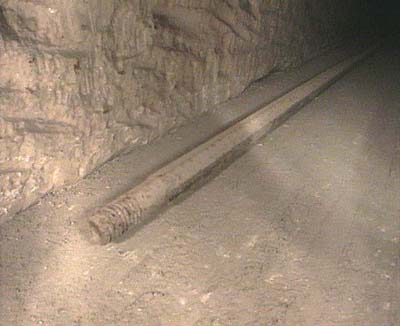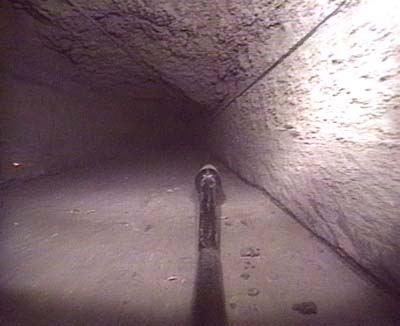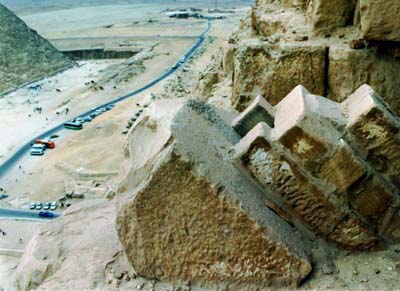|
The first 1992 campaign began in March and lasted two weeks. The GAI. provided me their Photogrameter Ulrich Kapp for the full period, and for several days each, two different Egyptian workers, Mohammed and Abdel Nasr, as assistants.
(See THE TEAM members page)
Because the ventilation equipment was not yet ready, we embarked on the original plan - video inspection of the shafts. At this time, the Egyptians were still reluctant to close the Pyramid for our investigation, so we could not work on the outlets of the shafts. In particular, the outlet of the upper northern shaft  lies 80 meters directly above the tourist entrance to Cheops, and the risk of falling stone was simply too great. lies 80 meters directly above the tourist entrance to Cheops, and the risk of falling stone was simply too great.
But it was possible to close off the corridor leading to the Queen's Chamber, allowing us to work in relative peace there, where the two lower shafts begin. Almost immediately, however, I discovered that the shafts showed evidence of serious settling, due to the thrust of the chamber roof beams.

Settling inside the southern Queens Chamber shaft
The settling of the southern Queens shaft  amounted to 4 cm, leaving a passage space of about 16.5 cm, but unfortunately my robot had a minimum height of 17 cm - it was too tall to get through, by a grand total of 0.5 cm! After all my careful calculations and enormous preparatory work and expense, an immensely frustrating revelation. Determined not to be stalled before I'd even gotten started, I tried to squeeze the robot through the narrows - and it got stuck. In order to extract it, I had no choice but to break off several parts, adding pain to vexation. amounted to 4 cm, leaving a passage space of about 16.5 cm, but unfortunately my robot had a minimum height of 17 cm - it was too tall to get through, by a grand total of 0.5 cm! After all my careful calculations and enormous preparatory work and expense, an immensely frustrating revelation. Determined not to be stalled before I'd even gotten started, I tried to squeeze the robot through the narrows - and it got stuck. In order to extract it, I had no choice but to break off several parts, adding pain to vexation.
Nonetheless, we did manage to push the robot and its TV camera a distance of just over 12 meters into both shafts. Egyptologists had always maintained that the lower shafts were only token or insinuated constructions. In this conventional view, these "shafts" were probably quite short, perhaps only 3 to 4 meters long, and simply implied a passageway for the escape of the pharaoh's soul. Thus, went this theory, there had been no reason for the pyramid builders to complete them.
So despite my bitter disappointment at not being able to proceed farther, we had already succeeded in blasting some serious holes in that theory.
In the northern shaft we could even see the end of a long rod, extending up farther into the shaft. The rod was most likely left behind by Waynman Dixon in 1872 when he chiseled open the walls of the Queen's Chamber to expose the lower openings of the shafts, which had originally been closed - and thus totally invisible.

The end of the "Dixon iron rod", approximately 12 m inside the shaft.
Apparently many Egyptologists never bothered to read the Dixon notes, which provided many clues to the length of the lower shafts. Dixon built fires at the base of both lower shafts. The smoke soon dissipated in the southern one, but not in the northern, suggesting at least that the northern shaft was much shorter than the southern one. In fact, it may not extend beyond the level of the Great Gallery.
As the pyramid was not closed to the public during our investigation, we were able to work on the upper shafts  for only two hours each morning, prior to the official opening hour for the tourists. But in practice, we had to share the interior with crowds of spiritualists and their followers, which led to no little frustration on both sides. for only two hours each morning, prior to the official opening hour for the tourists. But in practice, we had to share the interior with crowds of spiritualists and their followers, which led to no little frustration on both sides.
The opening of the lower northern shaft was simply too small to admit the robot at all, so I made the decision to forget it for the time being and wait for a new and smaller robot.
We then disassembled the robot and tried to tow the lower part only through the upper southern shaft, using a towline attached at the upper outlet. But 9.6 m in, we ran into a block left unfinished by the builders. This reduced the height of the shaft to only 11 cm, and once again we were stymied.

More than a tight fit! The minimum height of the first robot and the
actual height of the unfinished block.

The same spot seen through the eyes of UPUAUT-1.
Note the tow wire along the right wall, 8 cm above the floor.
Unable to accomplish much more with the robot, we began clearing debris out of the upper shafts and measuring the exact positions of their outlets. We also made a complete survey of the Caviglia Tunnel  and attached a safety rope to the outlets of the upper shafts. I discovered that of the 14 Maragiolio and Rinaldi * measurements I required for my computer analysis, 12 were imprecise or simply false - on what was supposedly the "best surveyed monument" in history. So we spent the rest of the time available to us re-measuring a number of points of the pyramid's exterior and interior. and attached a safety rope to the outlets of the upper shafts. I discovered that of the 14 Maragiolio and Rinaldi * measurements I required for my computer analysis, 12 were imprecise or simply false - on what was supposedly the "best surveyed monument" in history. So we spent the rest of the time available to us re-measuring a number of points of the pyramid's exterior and interior.
(* V. Maragiolio & C. Rinaldi / L´Architettura Delle Piramidi Menfite / Parte IV)

The outlet of the upper southern shaft.
The smaller, inclined blocks are not original and were probably placed
during an unreported restoration campaign of the early 19th century
Then there was nothing left to do but pack up and go home, for a break of about one month. After the problems encountered during the first campaign, I decided to concentrate on the upper shafts. I wanted to get a better idea of their exact dimensions and variations, and thus obtain data crucial for construction of the next generation robot - "Upuaut-2" - that would explore the Queen's Chamber shafts in 1993.
By now I had realized that since the upper shafts penetrate to the outside of the pyramid, I could pass a towing cable through them. So I spent the next four weeks completing the second robot as a towing sledge, incorporating the video camera from the first one. It was also fitted with a front mounted-rod with three lasers to measure the height and width of the shafts as we progressed through them. It was Prof. Stadelmann who suggested the name, in commemoration of the ancient Egyptian god, Upuaut.
During this same period the exact dimensioning of the ventilation system was calculated from my data by LTG, using computer simulation. The niches for the ventilation units in the pyramid were re-checked, and all the equipment was again shipped through the German Embassy to the GAI in Cairo.
THE UPUAUT STORY THE SECOND 1992 CAMPAIGN THE 1993 CAMPAIGN
|
![]() navigation button
navigation button






